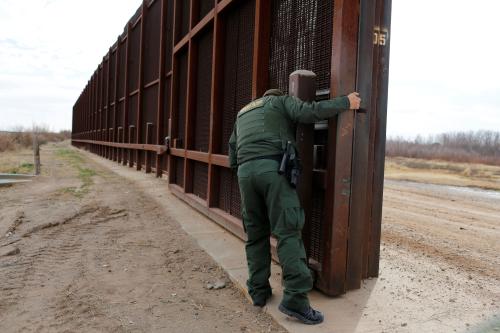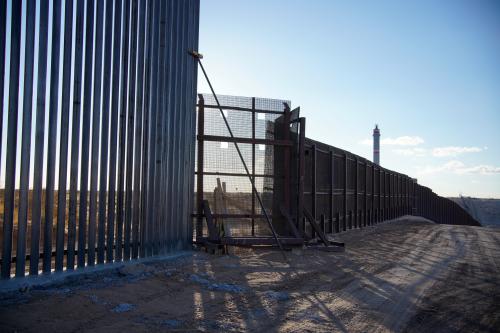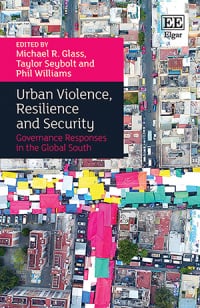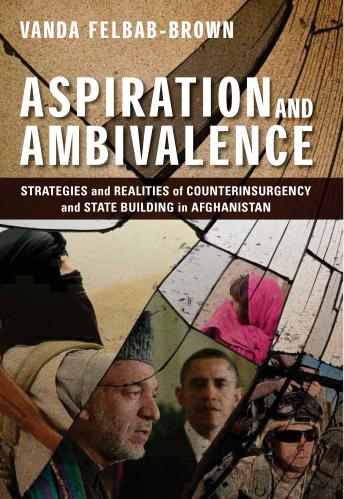The story of the anti-immigration vigilante groups at the U.S.-Mexico border is yet another demonstration of how allowing citizens to take the law into their own hands rapidly spins out of control and easily comes to threaten the very political and legal order in a country, writes Vanda Felbab-Brown and Elisa Norio. This piece was originally published by La Reforma’s Mexico Today.
The January 6, 2021 insurrection carried out by Donald Trump’s supporters on the U.S. Capitol has its antecedents in decades of border activities by U.S. right-wing armed groups and self-styled militias at the U.S. Mexico border. The various right-wing armed groups grew particularly potent and visible during the Trump presidency, with at least implicit support from Trump himself. They spread throughout the country and sought to influence nation-wide politics to an unprecedented degree, even attempting to violently reject the result of the presidential election under the threat of a full-blown political insurrection.
Some of them originate in or have interacted with anti-immigrant vigilante groups who sometimes erroneously self-identify themselves militias groups. These groups have operated at the U.S.-Mexico border since the 1980s with the self-styled mission to stop undocumented migrants. Many of the right-wing armed groups’ tactics exhibited during Trump’s presidency – harassment of minorities, purposeful recruitment of military veterans, cultivation of allies in law enforcement forces and among politicians, and efforts to influence elections – had years of beta testing at the U.S.-Mexico border.
Examples of Border Vigilante Groups
During the first decade of the 21st century, “Minuteman” groups were among the most prominent militias. Their movement, known as the Minuteman Project, was started by Jim Gilchrist, an ex- Marine and a former local newspaper reporter, and Chris Simcox, an Arizona newspaper publisher. Eventually claiming to have a membership of several hundred heavily-armed volunteers across several U.S. states, the group described its activities as “Vigilance Operations monitoring immigration, business, and government.” Although the border groups publicly disavowed a connection with white supremacy, racist, and separatist groups, their members often had overlapping affiliations with organizations that subscribed to those ideas.
Ranch Rescue, established in the 1990s by former Cochise County, Arizona Deputy Sheriff Roger Barnett was another prominent group. Barnett boasted Ranch Rescue had detained over 12,000 “illegal immigrants” between 1996 and 2006. He organized a set of volunteers who dressed in uniforms resembling the legitimate U.S. Border Patrol, carried weapons, and roamed both the border and border communities to deter immigration to the United States. Other such groups include, for example, the Arizona Border Recon.
Patrolling the border against undocumented migrants, and Mexican cartels smuggling drugs to the United States, has also become a key activity of other right-wing armed groups from across the United States, who which aspire to a far wider set of objectives beyond just border activities. Take, for example, the Three Percenters, founded in 2008. A part of so-called Patriot Movement, the Three Percenters advocate highly-permissive gun ownership and oppose the federal government, with their name derived from the erroneous claim that only three percent of colonists actively fought against the British in the American Revolution. Many members of the Three Percenters are former or even current members of the U.S. military or law enforcement agencies.
For many paramilitary groups like the Three Percenters, anti-migrant and other border patrol activities have become not only a purpose in of itself, but also a training exercise for a much wider agenda, including challenging the existing U.S. constitutional order.
Tactics of the Self-Style Militias
Preventing illegal border crossings has long been one of the principal activities of self-styled militias. This effort has ranged from actually detaining individuals at the border whom the groups suspect not to have valid documents — an activity that is illegal under U.S. laws (as is impersonating U.S. law enforcement agents) — and handing them over to the U.S. Border Patrol, to calling in information to the Border Patrol on the presumed undocumented. After U.S. civil liberty groups highlighted the unlawfulness of the vigilante groups actually detaining individuals, some of the vigilante groups purportedly re-centered on merely observing migrants, without initiating physical contact.
Yet, even being the target of observation can lead to harassment and intimidation and deter otherwise lawful or protected behavior. Various border vigilante groups have showed up at employment sites where day laborers gather and videotaped the laborers, potential employees, and passersby. Similarly, these groups also set up surveillance and film people in neighborhoods with large migrant populations and at hospitals and clinics frequented by undocumented migrants, with the effect of deterring those who need medical help from seeking it.
These tactics at and near the border and in communities with high migrant populations provided a preview of the activities of the various right-wing armed groups who showed up at Black Lives Matter protests and other events to deter and intimidate the protestors, under the pretext of protecting private property and public monuments.
Staking out polling stations supposedly to monitor the integrity of elections (which right-wing armed groups sought to do in the U.S. 2020 presidential election) is yet another tactic rehearsed more than a decade and half ago by the anti-immigrant border vigilante groups. During elections, they would post themselves near polling stations in area of high percentage of people of color and videotape those going in to vote. Their claimed purpose was to deter the undocumented from voting, but, of course, such tactics can also deter many legal citizens from voting, particularly marginalized minorities.
And just as today radical right-wingers are diligently cultivating local and national political supporters, including law enforcement officials, business owners, and elected politicians, for two decades, the border vigilante groups similarly sought to cultivate political capital with such influential actors.
For example, the border vigilantes cultivate influence through their advocacy of gun ownership, an end in and of itself and a tactic. In turn, gun store owners have sought to cultivate support among the vigilante groups, seeing them as key customers and natural allies.
Back in the 1990s and 2000s, the border vigilante groups received support from numerous legislators and politicians. Gilchrist of the Minuteman Project received support from then Arizona Senate president Russell Pearce. Some representatives, such as Arizona Republican Joseph Sweeney, have been both elected officials and members of vigilante groups, with Sweeney volunteering to participate in the Minuteman groups. Most dramatically and dangerously, in May 2006, Representative Virgil H. Goode Jr., a Virginia Republican, along with other representatives from as far away as New Jersey and Pennsylvania, sponsored legislation to give official status to the border vigilante groups. The legislation also sought to prevent the Department of Homeland Security from undermining the vigilantes’ activities.
Inadequate and Problematic Response
Yet for many years, law enforcement agencies on the border tolerated the active operations of the militias and sometimes encouraged them. For example, during the 2000s, U.S. law enforcement agents at various times avoided prosecuting groups like the Minutemen even for unlawful detentions of migrants. Similarly, despite the fact that members of the Ranch Rescue were involved in numerous incidents in which they detained Mexican and Hispanic migrants whom they assumed were undocumented, local law enforcement agents as well as Cochise County and Arizona attorneys general repeatedly refused to prosecute Barnett and other members, citing a lack of evidence.
Some of the groups even received praise from unions supporting the U.S. Border Patrol. In other cases, local police officers operating at the border similarly expressed admiration and approval for the actions of the vigilante groups.
Oscillating between apathy and approval, such official responses endowed the groups with a sense of impunity and augmented their capacities, by de facto facilitating their training and learning from their experiences — setting dangerous precedents for other right-wing armed groups.
Only in recent years have U.S. federal law enforcement authorities adopted a more robust, prosecution-oriented response toward the border vigilantes. In March 2019, then U.S. Customs and Border Protection (CBP) Commissioner Kevin McAleenan said his agency, which runs U.S. Border Patrol, did not need help from citizens to protect the border. A few days later, the leader of the United Constitutional Patriots, another of the border vigilante groups at the U.S.-Mexico border, was arrested by the Federal Bureau of Investigation for illegally detaining hundreds of migrants in New Mexico.
Synchronization and Consolidation
But this attention of law enforcement authorities to the danger of the border vigilante groups has come rather late, having in the meantime allowed the vigilantes to instruct other right-wing groups, integrate with them, and spawn.
Those developments over the past decade are in striking contrast to the fate of the border militias in the 1990s and early 2000s. Then, many (including the Minuteman groups) ultimately self-destructed and became divided and splintered. Often the reason for the self-destruction was too blatant an engagement in serious criminality and subsequent law enforcement actions against them. The Minutemen American Defense group, founded by Shawna Forde and Jason Bush in 2007, disintegrated after Forde and Bush attempted to fund their vigilante group through armed robbery in the border town of Arivaca, Arizona, during which they murdered Raul Flores and his nine-year-old daughter.
Another vigilante group in this ecosystem of paramilitaries, the Minuteman Civil Defense Corps, also underwent multiple splintering. In 2012, its leader J.T. Ready, a neo-Nazi Marine vet, killed himself, his girlfriend, and three of her family members. He had been subject of an FBI investigation into the murders of a number of migrants. Simcox of the original Minuteman Project was charged with six counts of child molestation and captured by his former lieutenant in the Minuteman Project who started a bounty hunting firm.
However, even when leaders of various groups were arrested and the groups fell apart, their ideas lived on, as has the concept of the U.S.-Mexico border as a place of training, self-justification and purpose, and opportunities to establish contacts and networks with other right-wing armed groups and build political capital. The nonstate armed groups festering at the U.S.-Mexico border became a cradle and a high school for right-wing armed groups all around the United States.
What to Do Today
New flows of migrants heading to the U.S.-Mexico border during the Biden administration will provide new self-justification, purpose of existence, and a recruitment tool for right-wing armed groups. As part of its praiseworthy immigration reform package, the Biden administration must also develop resolute policies toward the self-styled militia groups operating at the border and other right-wing armed groups attracted there from other parts of the United States.
As a start, the Biden administration should clearly instruct the U.S. Border Patrol not to interact or cooperate with the vigilante groups in any way, and to encourage the FBI to diligently prosecute members of these groups for any possible law infractions. It should also encourage local police departments to do so, even while the vigilantes seek to coopt them and cultivate alliances within them.
Sending members of the militia groups to prison may not prove insufficiently effective. Even after serving their terms, many will return to the right-wing armed groups. The groups provide their members, including convicted felons, with a normative self-justification, a sense of belonging, and access to weapons, even though such access for those convicted of felonies would violate federal law. Yet, for many militia members, their self-worth often is inextricably tied to weapons possession. When they can no longer buy the weapons themselves, membership in the groups may facilitate their renewed access to arms. Moreover, many members of the border vigilante groups are not principally motivated by racism and nativism. Instead, what some crave is a sense of camaraderie combined with a grander purpose, the same feelings of belonging and self-worth the used to experience while servicing in the U.S. military in wars abroad. Even those who did not serve enjoy that sense of belonging heightened by the adrenaline-producing group actions.
Thus, beyond diligent prosecution of all criminal offenses and severing of any positive relations between law enforcement agencies and members of border vigilantes and other right-wing armed groups, the policy response must also entail sophisticated rehabilitation of ex-felons so they do not gravitate back to the self-styled militias. Prevention is equally needed via:
a) providing far better assistance to U.S. veterans and facilitating their smooth and fulfilling transition to civilian life, and
b) limiting the exposure of U.S. soldiers to bloody far-away wars by making U.S. foreign policy and counterterrorism efforts far more selective in the wars we take on.
The story of the anti-immigration vigilante groups at the U.S.-Mexico border is yet another demonstration of how allowing citizens to take the law into their own hands rapidly spins out of control and easily comes to threaten the very political and legal order in a country. It is also a powerful lesson that U.S. policy toward right-wing armed groups must be multifaceted as well as determined.
The Brookings Institution is committed to quality, independence, and impact.
We are supported by a diverse array of funders. In line with our values and policies, each Brookings publication represents the sole views of its author(s).










Commentary
What border vigilantes taught US right-wing armed groups
March 12, 2021